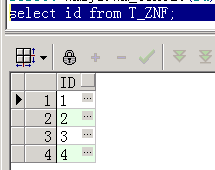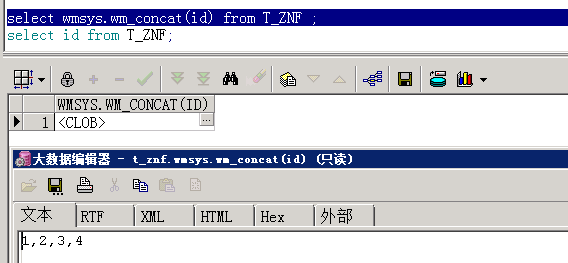1、wmsys.wm_concat和listagg
将多行数据整合到一行,用逗号分隔。


在oracle 12c数据库中,是listagg

2、dbms_random.random和dbms_random.value(0,100)
1 --随机排列 2 select * from t_znf order by dbms_random.random; 3 --随机整数 4 select trunc(dbms_random.value(1,100)) from dual;
3、decode
decode(字段,result1,value1,result2,value2,...,default)
相当于if..else if ..else .
select a.*,decode(id,1,'ID=1',2,'ID=2',3,'ID=3','ID默认值') from t_znf a ;
当t_znf.id = 1,返回'ID=1',为2时,返回'ID=2',为3时,返回'ID=3',当ID值为其他时,返回默认值:'ID默认值'。

4、NULLIF
NULLIF(exp1,expr2)函数的作用是如果exp1和exp2相等则返回空(NULL),否则返回第一个值。
select a.*,nullif(id,3) from t_znf a;

5、NVL2
NVL2函数的格式如下:NVL2(expr1,expr2, expr3)
含义是:如果该函数的第一个参数不为空,返回第二个参数的值,如果第一个参数的值为空,则返回第三个参数值。个人感觉有点像java的三目预算 expr1?expr1:expr3
select a.*,nvl2(a.state,a.state,a.t_desc) from t_znf a ;
当t_znf.state 不为空,返回 state,为空时,返回 a.t_desc;

6、substr
substr(字段,开始位置,截取长度),注意字符串的开始字段是1。
select a.*, substr(a.t_desc,1,5),a.rowid from t_znf a;

7、length
计算字段长度
select A.*,LENGTH(A.T_DESC) from T_ZNF A;

8、replace
replace(exp,old_str,new_str):用new_str 替换掉 exp 中所有的 old_str。
select a.*,replace(a.t_desc,'A','BBB') from t_znf a;
用BBB代替t_znf.t_desc中的A

可以用replace 去掉字符串中所有的空格
select replace(' hello world ',' ','') from dual;

9、TRIM、RTRIM、LTRIM
trim(exp):去除 exp字符串前后的空格
rtrim(exp):去除 exp字符串右边(right)的空格,即去除字符串尾部空格
ltrim(exp):去除 exp字符串左边(left)的空格,即去除字符串开头空格
如果需要去除所有空格,用replace
select trim(' hello world ') from dual;

去除尾部空格

去除开头的空格

10、round
按精度四舍五入

11、mod
取余函数,该函数可以用于并列处理 数据的更新。比如:存过更新一个超大表,可以对ID进行取余,进而并发执行存过。
CREATE OR REPLACE PROCEDURE P_update_T_ZNF(seq in number) CURSOR C1 IS select t.ID from T_ZNF t where t.flag = 'N' --是否已经处理的标识 and mod(t.id, 10) = seq and rownum < 160001; BEGIN --数据处理 END;
可以打开10个窗口并列执行 call P_update_T_ZNF(seq),seq的值为0-9,这样大大加快的数据的处理速度。
曾经有个数据的更新,执行了一个晚上也没有执行完,后面用取余函数,并发执行,两个小时执行完了。
12、sign符号函数
SIGN(n)函数是一个符号函数,他的功能是返回(1或0或-1)
当 n < 0 返回 -1
n = 0 返回 0
n > 0 返回 1
n = 0 返回 0
n > 0 返回 1
DECODE(VALUE, if1,then1, if2,then2, if3,then3, DEFAULT)
3、SIGN()与DECODE()结合使用示例:
当LEVEL<5输出low
当LEVEL<8输出mid
ELSE输出high
当LEVEL<5输出low
当LEVEL<8输出mid
ELSE输出high
SELECT LEVEL, DECODE(-1, SIGN(LEVEL-5),'low', SIGN(LEVEL-8),'mid', 'high') FROM dual CONNECT BY LEVEL < 10;